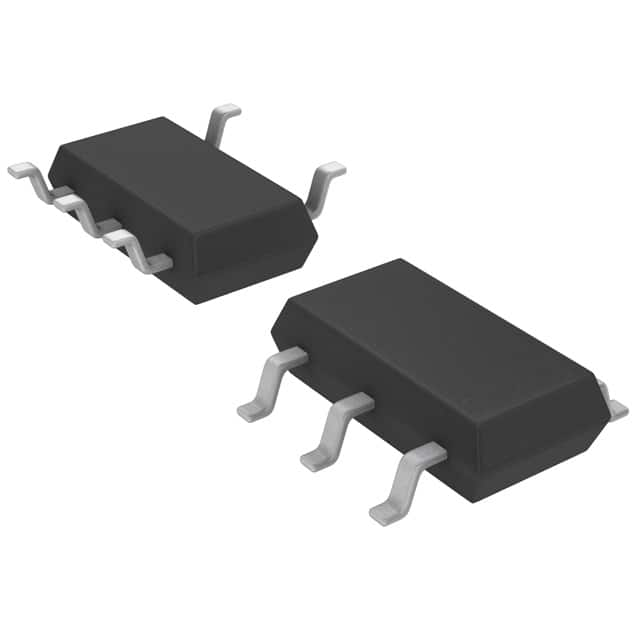Consulte las especificaciones para obtener detalles del producto.

LTC1694-1CS5#TRPBF
Product Overview
Category
The LTC1694-1CS5#TRPBF belongs to the category of integrated circuits (ICs).
Use
This product is commonly used in electronic devices for signal conditioning and level translation applications.
Characteristics
- The LTC1694-1CS5#TRPBF is a low voltage, dual-supply level translator.
- It operates over a wide voltage range, making it suitable for various applications.
- This IC has high-speed performance, enabling efficient signal processing.
- It offers low power consumption, making it energy-efficient.
Package
The LTC1694-1CS5#TRPBF is available in a small SOT-23 package, which is compact and easy to integrate into circuit designs.
Essence
The essence of this product lies in its ability to translate signals between different voltage levels, ensuring compatibility between different components in an electronic system.
Packaging/Quantity
The LTC1694-1CS5#TRPBF is typically packaged in reels or tubes, with a quantity of 3000 units per reel/tube.
Specifications
- Supply Voltage Range: 1.6V to 5.5V
- Logic Voltage Range: 1.6V to 5.5V
- Operating Temperature Range: -40°C to 85°C
- Input/Output Capacitance: 3pF
- Maximum Data Rate: 20Mbps
Detailed Pin Configuration
The LTC1694-1CS5#TRPBF features the following pin configuration:
- VCC1: Positive supply voltage for logic side
- GND1: Ground for logic side
- A1: Logic input/output 1
- B1: Logic input/output 2
- VCC2: Positive supply voltage for translation side
- GND2: Ground for translation side
- A2: Translation input/output 1
- B2: Translation input/output 2
Functional Features
- Bidirectional level translation between two voltage domains.
- Automatic direction sensing and control.
- High-speed operation for efficient signal processing.
- Low power consumption for energy efficiency.
- Wide operating voltage range for versatility.
Advantages and Disadvantages
Advantages
- Efficient signal conditioning and level translation.
- Compact SOT-23 package for easy integration.
- Wide voltage range compatibility.
- High-speed performance.
- Low power consumption.
Disadvantages
- Limited maximum data rate of 20Mbps.
- Temperature limitations (-40°C to 85°C).
Working Principles
The LTC1694-1CS5#TRPBF utilizes a combination of level shifting circuitry and automatic direction sensing to translate signals between different voltage domains. It detects the logic levels of the input signals and adjusts the output levels accordingly, ensuring compatibility between different components in an electronic system.
Detailed Application Field Plans
The LTC1694-1CS5#TRPBF finds applications in various fields, including:
- Industrial automation: Used for signal conditioning in control systems.
- Automotive electronics: Enables level translation between different subsystems.
- Consumer electronics: Facilitates communication between devices with varying voltage levels.
- Telecommunications: Ensures compatibility between different network interfaces.
- Medical devices: Provides level translation for medical equipment.
Detailed and Complete Alternative Models
- SN74LV1T34DBVR: Single-supply voltage translator with similar characteristics.
- TXB0104PWR: Quad-bit bidirectional voltage-level translator with higher data rate capability.
- PCA9306DCUR: Dual bidirectional I2C-bus and SMBus voltage-level translator.
These alternative models offer similar functionality and can be considered as substitutes for the LTC1694-1CS5#TRPBF in specific applications.
Word count: 524 words
Enumere 10 preguntas y respuestas comunes relacionadas con la aplicación de LTC1694-1CS5#TRPBF en soluciones técnicas
Sure! Here are 10 common questions and answers related to the application of LTC1694-1CS5#TRPBF:
Q1: What is LTC1694-1CS5#TRPBF? A1: LTC1694-1CS5#TRPBF is a specific model of a digital isolator IC (integrated circuit) manufactured by Linear Technology (now part of Analog Devices). It is commonly used for signal isolation in various technical solutions.
Q2: What is the purpose of LTC1694-1CS5#TRPBF? A2: The purpose of LTC1694-1CS5#TRPBF is to provide galvanic isolation between two parts of an electronic system, allowing signals to pass through without any direct electrical connection.
Q3: What are the key features of LTC1694-1CS5#TRPBF? A3: Some key features of LTC1694-1CS5#TRPBF include high-speed operation, low power consumption, wide temperature range, and compatibility with various communication protocols.
Q4: How does LTC1694-1CS5#TRPBF achieve signal isolation? A4: LTC1694-1CS5#TRPBF uses capacitive coupling and digital encoding techniques to transmit signals across the isolation barrier while maintaining electrical isolation.
Q5: What are the typical applications of LTC1694-1CS5#TRPBF? A5: LTC1694-1CS5#TRPBF is commonly used in applications such as industrial automation, motor control, medical devices, power supplies, and communication systems where signal isolation is required.
Q6: What is the voltage rating of LTC1694-1CS5#TRPBF? A6: LTC1694-1CS5#TRPBF has a maximum voltage rating of typically around 5V, which means it can handle signals within that range.
Q7: Can LTC1694-1CS5#TRPBF be used for bidirectional signal transmission? A7: No, LTC1694-1CS5#TRPBF is a unidirectional digital isolator, meaning it can only transmit signals in one direction. For bidirectional communication, two isolators are usually required.
Q8: What is the maximum data rate supported by LTC1694-1CS5#TRPBF? A8: The maximum data rate supported by LTC1694-1CS5#TRPBF is typically around 10 Mbps (megabits per second), making it suitable for high-speed communication applications.
Q9: Is LTC1694-1CS5#TRPBF compatible with different supply voltages? A9: Yes, LTC1694-1CS5#TRPBF is designed to work with various supply voltages, typically ranging from 2.7V to 5.5V, providing flexibility in different system configurations.
Q10: Are there any specific precautions to consider when using LTC1694-1CS5#TRPBF? A10: It is important to follow the manufacturer's guidelines and datasheet recommendations for proper usage and layout considerations to ensure optimal performance and reliability of LTC1694-1CS5#TRPBF in your technical solution.
Please note that the answers provided here are general and may vary depending on specific application requirements and the manufacturer's specifications.

